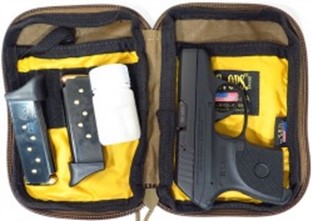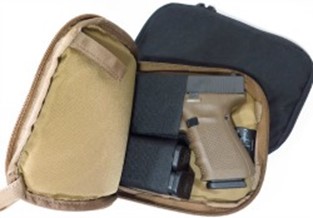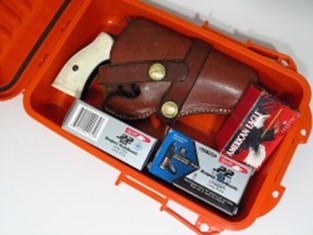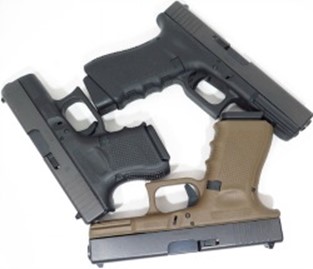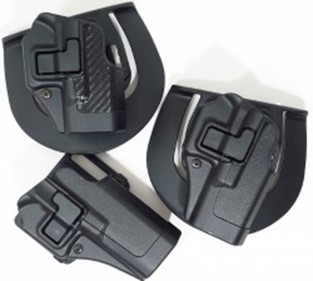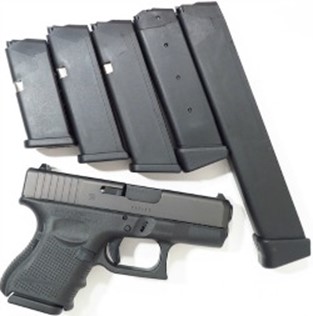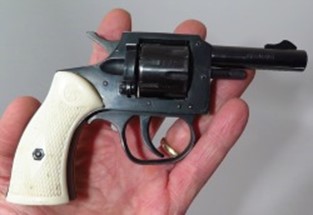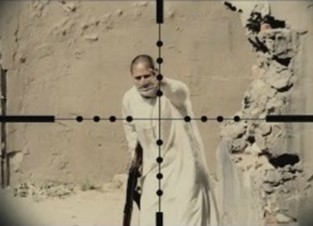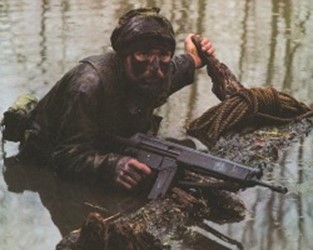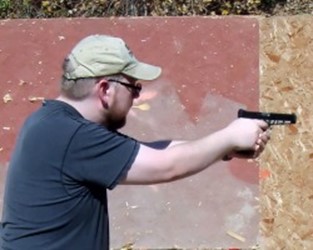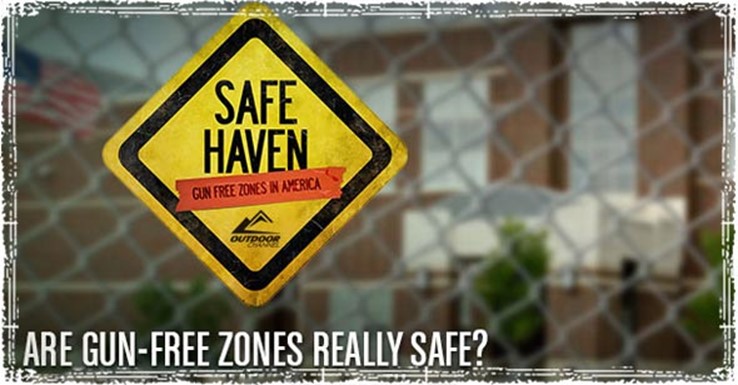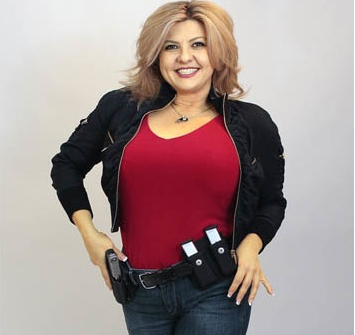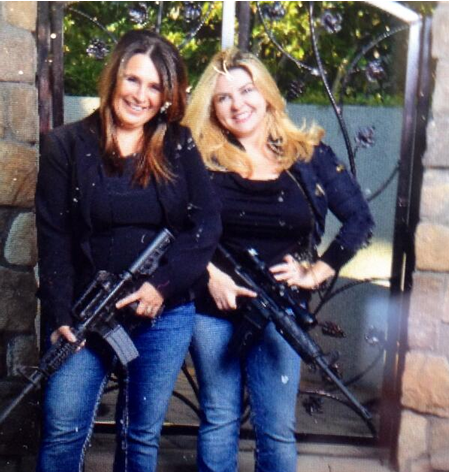Guest post by Doc Montana
——————-
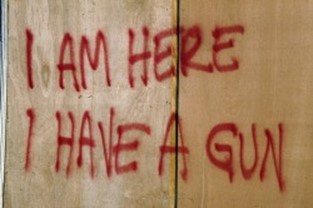
Almost overnight Katrina turned from a woman’s elegant name, to a tragic hurricane, to an adjective for a tangible survival situation. So when the word Katrina is used to qualify a rifle, it should be clear that the intended use of the rifle will not be for anything fun. This particular Katrina Rifle (KR) project takes into to consideration the likely environment in which it may come into play for me; namely the western US. Defining that playground, some of the conditions that the rifle must operate within include a wide temperature range from freezing blizzard to forest fire. Targets could be anywhere from point blank to 300 yards away. The gun must run in full daylight, in darkness, and any lighting in between.
The rifle will be carried for 99.99 percent of its life so lightweight and comfort must be considered. It must be intensely reliable, of common caliber, and have replaceable parts. Finally, it must be as simple as possible but not any more so. Therefore every part and aftermarket add-on must be worth its weight in survival. So far, this might sound like every other rifle build. The list of jobs this rifle will fulfil include general security, close quarter combat, night patrols, long and short range hunting, 24/7 carry, long range shots, rapid fire, sniping, operating when dry, wet, and abused.
The Platform
Of the three popular actions, pump, bolt and semi-auto, the latter is the one of choice. Being able to repeatedly fire with only one hand is more important than anything the other two actions have to offer. While the semi-auto may have feeding or ejection issues where the pump and bolt won’t, I am going to take the risk on the semi-auto action. So as a semi-auto rifle, the next question is what major platform, AK or AR? If AK, then the the two choices are 5.45×39 or 7.62×39. If AR, then it is 5.56/.223 or .308. Frankly, any of the four would be great options so this could be considered a judgement call by the operator. In this case, even though I think the AK platform is the most durable and reliable and I even have time behind the sights of a full auto AK, I am going the AR route due to the proliferation of quality and proven aftermarket add-ons that will suit my Katrina Rifle build needs. Plus I already have a job so I don’t need another job trying to get an AK up to the starting specs of a upper-end AR. This isn’t Mad Max’s world…yet. I have time to do what I want and do it right according to my plan and my preferences. On the caliber front, I have to consider more than just the firepower. I need to think about who will be operating it, how much ammo to carry, and what are the likely targets. In this case, I am going to choose the 5.56 for the same initial reasons the US Military did; more ammo, plenty of power, lighter recoil, and flexibility. So having narrowed the starting point down to the highly predictable AR-15 platform in 5.56/.223, I could now get busy with the rest of Katrina.
The base rifle I chose was a Franklin Armory M4 SBR-L. Why? Because from the moment I held it, I knew it was the gun for me. The balance was impeccable, the billet receiver was a sensuous beauty, and the handguard was built for human hands. My hands. I’ve never tried to hid my fondness for the Franklin AR. It’s a wonderful piece of machinery. Considering that the rifle may live for hours at a time in my tight grip, I wanted a handguard that my hands approved of and the free float is just icing on the KR cake, as is the fireproof 7075-T6 aluminum. I also ran Katrina tests with my super-basic DPMS Panther, and my Smith & Wesson M&P15 that I tricked out as my horder rifle by loading every cool and shiny (but still functional) accessory into it just to see how it ran. I tried to keep the DPMS as light, simple, and fluid as possible, and ran the Smith heavy and heavily accessorized knowing full well that the best and least would migrate to my Franklin.
Ten Important Things For A Katrina Rifle:
-
Sling and Mounts
Imagine wearing the rifle on your back or across your chest for hours on end while you do other tasks and walk great distances. The rifle is slung across your shoulder while you cook, while you carry supplies, and even while you sleep. The sling must be easily adjustable and wide enough to be comfortable. The popular attachment options are clips, quick-detach, and threaded with tri-buckle. Clip connections are the most versatile and just as fast as QDs. While dedicated QD attachment point slings are gaining popularity, they are limited by the number and location of QD ports on the rifle. But there is a solution that gives both clips and QDs equal footing and harnesses the advantages of both. QD attachment swivels with metal ovals or triangles for sling clips are strong and flexible solutions. I can also attach shoulder pads to the sling including very nice ones procured from high-end computer bags. Recommendation: Magpul MS3 withGG&G triangular QD rings.
-
Adjustable Stock
I’ll admit, the telescoping buttstocks are cool. But the practical benefits are great as well. Although long distance shooters turn up their collective noses at easily adjustable stocks because they are less stable than a fixed stock affecting accuracy at the human/gun interface, that is not of concern with a Katrina Rifle. Instead, the rifle must be able to fit a variety of shooter sizes, as well as make itself as small as possible on demand. Of the popular adjustable buttstocks, Magpul rises to the top of the heap in my opinion. The next question was which one. I narrowed it to four options in ascending order from simplest to a heavier feature filled; named the MOE, the CTR, the STR and the ACS.
Having run each and every one through some basic paces, I decided on the second from the top, namely the Magpul STR. The STR has more cheek weld than the CTR yet retains the locking or restriction (R) feature. The STR has less storage than the ACS, but a large chunk of empty real estate in the middle like the CTR is something I like. It makes an excellent grab point and useful hole for non-standard operations. The amount of storage in the ACS was an interesting problem to consider. On the surface, it would seem that more closet space in the stock is better, but what would go in there? A basic parts kit? Batteries? Cleaning supplies? Extra firing pins? More ammo? A compass? Knife? Fire starter? There is no end to all the survival goodies that could go in there. But a quick reality check shows that the Katrina Rifle is not the place to store supplies. There are much better storage options. And while a tiny issue, about half an inch to be exact, the ACS is slightly longer than the STR. For the pistol grip, I kept the Ergo grip with battery compartment that was OEM on the Franklin. I like the Ergo over the Magpul, of which I have two for comparison. The Ergo is a wonderful grip and one worthy of consideration. But it certainly won’t make or break the build. Recommendation: Magpul STR Buttstock
-
Ambidextrous Charging Handle
The traditional charging handle has worked for many decades so why change it? Especially with a quality ambidextrous replacement costs from $60 to $90. But something to consider is that there are three main points of operational activity on the rifle; the magazine, the charging handle, and the trigger. And the other two will be addressed in a moment. The ambidextrous charging handle does exactly what the OEM charging handle does except from either side, and either side means either hand, either palm, either hip, or either edge of any hard object. Cycling the bolt and to move a round into battery and to clear jams are the charging handle’s main functions. Although not as sexy and conspicuous as many other AR parts, the humble charging handle can make or break the rifle. But here’s one more thing to consider: first, if you are running scope, you might need the extra lateral reach of a wider handle. And second, non-standard surfaces can be used to charge your AR in emergencies so you might want a non-standard charging handle design that considers the necessary strength and girth to handle such abuse.
The Raptor is more than just an additional paddle on the right. The Raptor was designed from the ground up for superior strength, intense durability, and record-breaking pivot point pin size. If there is a failure, it will be downstream from the Raptor charging handle. Recommendation: Rainier Arms Raptor Charging Handle
-
Drop-in Trigger
After market triggers are a costly upgrade. There’s no doubt about it. So why spend the money on one for a KR? Two reasons: pull weight and durability. On the pull weight side, I wanted something much lower than the off-the-shelf pull. Something in the 3-4 pound range. Some might think this a little light, but considering anyone from child to grandma must be able to pull the trigger without pulling the sight off the target, that pull weight seemed about right without going so low as to have the rifle fire the moment a finger touched the trigger. Remember, this is a Katrina Rifle so I am less concerned that the rifle will go off too quickly than not at all, or at least not where it should be pointed. Durability is arguable here since the original equipment manufacturer (OEM) triggers have proven themselves strong. But that’s when things are running well. Since the trigger is a rather fragile component of the rifle, as well as one that has been known to go out of tune just when its time to solo. A few engineering upgrades in the trigger department are welcome here as well as some extra plates of steel or aluminum enclosing the trigger mechanism.
Both Timney and CMC make great drop-in triggers in the weight range I am looking for. Timney makes 3 and 4-pound drop-ins that have a majority of their intestines surrounded by aluminum. And CMC makes a 3.5 pound pull drop-in beast almost completely enclosed in steel. Both attach to the lower with more security than traditional pins offer. The Timney retails for about $25 more than the CMC, and both are available online and in stores. On a side note, it seems that some of the enclosed drop in triggers might be infringing on each other’s patents given that some product lines appear then disappear. Recommendation: CMC 3.5 lb. Drop-in Flat Trigger
-
Electronic Optic
An electronic optic is always a debatable add-on. The minimalist crowd will sing the song of simplicity while the tactical troop will want every battery powered advantage. On my Katrina Rifle, I chose to mount an Aimpoint between my hard sights. The justifications are three-fold because there are undeniable advantages of a red dot over iron sights in many situations, and “Katrina” is one of those situations. 1) Target acquisition is much faster with a red dot especially in dark or obscure conditions. With both eyes open, the red dot floats in the air like a video game sight. Situational awareness increases dramatically over irons especially when eye relief can vary from an inch to a foot. 2) Less skill is needed to aim a red dot compared to lining up a front sight post on a target all through the center of a tiny hole inches from your eyeball. Imagine handing “Katrina” to a friend or family member who has little or no experience with the rifle. And 3) Red dots are so much easier to use than iron sights when injured, shooting from an awkward position, or when also struggling eye issues like smoke, dust, punches or lost glasses. EOTech makes great sights, but for this build, battery life trumps about everything.
So why not Trijicon? One simple and controversial reason: radioactivity. This is my gun and my decision. I choose not to wear an optic that emits beta particles, especially when it may reside in the same spot against my spine hour after hour, day after day, and potentially week after week. I’ve read all the technical literature on the tritium gas tubes within the Trijicon and will agree that under normal use, the amount of radioactivity from the optic is a wash in the big picture. But there are always exceptions to “normal use” and I believe that my Katrina Rifle is one of those exceptions. My call. Your mileage may vary. Recommendation: Aimpoint Comp or the new T2 Micro
-
Back Up Iron Sights
The need for BUIS or Back Up Iron Sights had been done to death, but in this case there are two considerations, neither of which is the decision to include them. That was obvious. The first was material. While not running a piston gun, the issue of melting is of concern. What if the front end of the ended up exposed to tremendous heat or fire. Of course if the gun went into a furnace the rest of the Magpul polymer would fail, but ladies and gentlemen, we’ve got bigger problems if the rifle falls out of the frying pan and into the fire. Recommendation: Magpul MBUS Pro
-
Weapons Light
Half the day is night, and most building interiors are dependent on artificial light. When Katrina hits the fan, the rifle must operate 24/7, not just when the lighting is good. The desired qualities of the weapon’s light include immensely durable and watertight body; a blindingly bright beam pushing out at least 500 lumens; a simple I/O interface with pulse control and no strobe; a switch that can be operated with an object or edge as well as a finger or thumb; a small form factor that preserves the clean lines of the handguard; easily mounts and detaches on a Picatinny rail with one hand and without tools so it can double-duty as a flashlight; eats lithium 123 batteries for their long shelf life, long run time, and wide operational temperature range. I explored a 1000 lumen flashlight installed in a Picatinny rail mount as well as a light/laser combo, and a svelte bright flashlight held in hand. In the end I decided on a simple, powerful, and small Surefire light. The reasons include 500 lumens, a mounting system that with one hand can be quickly attached and detached from the rail, and a reputation for intense durability.
I’m sorry if I offend anyone, but if this is my last weapons light, I am choosing the best. And yes, I know there is a similar Surefire with laser, but I used to own one, and as much as I might be considered a Surefire fanboy, I was not excited with the x400 Ultra. It’s a great light, but the operational interface was not as friendly as I had hoped. But I will say that using the Streamlight TLR2-Green laser is a pleasant experience. Frankly, I am not totally sure skipping the laser is the best choice. Besides the durability issues, and the reduced battery life, the laser is larger and has two switches instead of one. Maybe is there is a heads-up to the Katrina event, I might switch to a laser. Either way, I prefer the under-barrel mount rather than a side or top-barrel mount. The shadow is on upper side and is of little consequence when outdoors. Further, or perhaps more importantly, any reflective light spill of the barrel is on the underside so no bright spots will interfere with targeting or eye night vision. Recommendation: Surefire x300 Ultra
-
Stealthy Case
Now these last three considerations are not accessories on the Katrina Rifle, but rather for supporting the Katrina Rifle. I am done attaching things to the gun so now I will consider the shelter, health, and feeding of the rifle. Let’s start with shelter. Hurricane Katrina was not a surprise. The mistakes causing the WROL were 100% human initiated with everything from city planning, to emergency response, to good old human nature mixing into a perfect storm of Charlie Foxtrot. Regardless of any updated laws or attitudes, a visible rifle will change the strategy of any observer regardless of what side of the law their body will fall on when things get wet. Casing your weapon will hide or at least confuse its shape, and some of the better stealth cases add just a couple seconds to gun deployment. Literally, just 2.2 seconds according the Renegade Ridge when describing their Liberator Discrete AR-15 case. There are many discrete case options, with some that look more like something else that others. Popular mimicry includes tennis racquet cases, violin and guitar cases, and non-descript ovaloids that look like unknown something else. I like the 5.11 Tactical COVRT, but if price is no object, then the Renegade Ridge really rocks the boat. The RR is designed for deployment as much as discreteness, and the build quality is off the charts. Recommendation: Renegade Ridge Liberator Discrete AR-15 Case
-
A Parts Kit
The health of your gun is a debatable topic. If your survival scenario includes a short but intense duration like Katrina proper, then cleaning and maintenance is not at the top of your list. But if running your gun over an extended period is a concern, then having a few extra important pieces might be helpful. Now this might sound like a contradiction since bolt action rifles have performed flawlessly for a century with no more than a light cleaning. Why would a last-ditch rifle be one that needed spare tires in the trunk? Very good question, and one I still ask myself. But the simple answer is that when using a semi-auto action, the number of moving parts increases and the chance of failure increases proportionately. Sorry about that, but it’s reality. The path of least resistance is a commercially available parts kit like the Rock River Arms, or CMG, but with Katrina knocking, it’s just the facts mam. Just the facts. The probability of failure with the amount of ammo I plan on carrying is pretty much zero. What’s going to go wrong with a few hundred rounds downrange? Sure, Murphy is alive and well, but that is really scraping the bottom of the worry bucket. Recommendation: Rock River Arms
-
Ammo Solutions
Feeding. What good is a rifle without ammo? So let’s consider some Katrina options. First, there is the 30 round mag that lives in the basement of the rifle. Think about it. Thirty shots is a seriously high number if you are really the good guy with a gun. But of course nothing goes according to plan. Especially Katrina events. So my KR is backed up with four more 30 round mags for a total of 150 bangs. Plenty of anyone on the run. That averages to five shots a day for a month. Still a lot. The solution is a quality dual-mag pouch. Plain and simple. The pouch can be belt-worn, carried in a pack, or affixed to the rifle sling. I can wedge four 30-round Magpul PMags with Magpul Ranger Plates into a Spec-Ops four mag pouch. It’s a tight fit, but that’s just added security, right? I have other mag-holding options, but if I gotta grab just one, the Spec-Ops is it. On a side note, I alleviate my fear of magazine spring compression-memory by loading my 30 rounders with only 20 rounds. If darkness appears on the horizon, I will pack in the remaining 10 rounds compressing the spring to its maximum. Unlike many unprepared folks, I prefer to be perpetually two thirds-ready with my Katrina Rifle magazines.
Go? No Go?
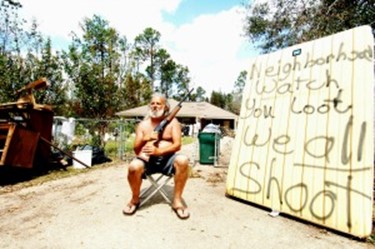
Given the amount of time I spend considering what I should have, I discovered several things I don’t need nor want for this very specific rifle. Here is the list of things I tried to implement, but gave up on or felt they weren’t the cost in weight or side effects. I consider the five things to avoid.
-
The Vertical Grip
I run a VG on my Smith, but that’s all. I noticed that the number of advantages of the VG is smaller than the number of problems it creates if shooting from hip or blasting back and forth without prejudice, then a VC is helpful. But for a full range of shooting positions and a minimum of weight, then the vertical grip can find a home somewhere else.
-
A Single Point Only Sling
If a paid operator or soldier of fortune is running security for some African warlord, then the single point is ‘da bomb. But carrying a Katrina Rifle 24/7 needs a traditional sling first, and one that can go all single-point only if needed.
-
A Sharp Pointed Flash Hider or Muzzle Brake
I’ll admit that there is something cool about a scalloped circle of pointed turrets on the business end of a rifle barrel, but in my non-scientific tests, I found that not only was the so-called .223 muzzle brake excessively loud, but that the sharpness did not add any more fear to the bad guy over the hellish black emptiness of 16 inches of s 5.56mm diameter hole in chrome-lined steel. Making matters worse, the sharp pointed muzzle break I used snagged and caught on almost every surface the rifle slid on nose first. And trying to slide it into a soft case was at times an exercise in futility.
-
The Bipod
I’ve never used a bipod that was both lightweight and stable. It’s always one or the other. Adding to that the limited number of times when you really need a bipod, my Katrina does not need this piece of jewelry to feel good about herself.
-
A Scope
There is absolutely no doubt that the use of a multiplying optic increases long range accuracy. But it is also true that the nature of a Katrina Rifle does not lean more towards the long range shots. While sometimes necessary, the multi-hundred yard shots are not the priority. A scope adds weight. It limits short range target acquisition. Unless battery operated, the scope is just as susceptible to darkness as human eyes. And what’s the advantage in that. Now if things go all good on us, then I’ll be the first to scope up my AR and go hunting, but until then its Aimpoint or iron.
Class is Over
As this apocalyptic exercise comes to a close, I’m satisfied with my creation. It is certainly not the only route to a Katrina Rifle, but anyone anywhere willing to plan at this level might need a little encouragement since and camaraderie.
Start now to make sure you are staying prepared.
Via: SHTFBlog








 Follow
Follow